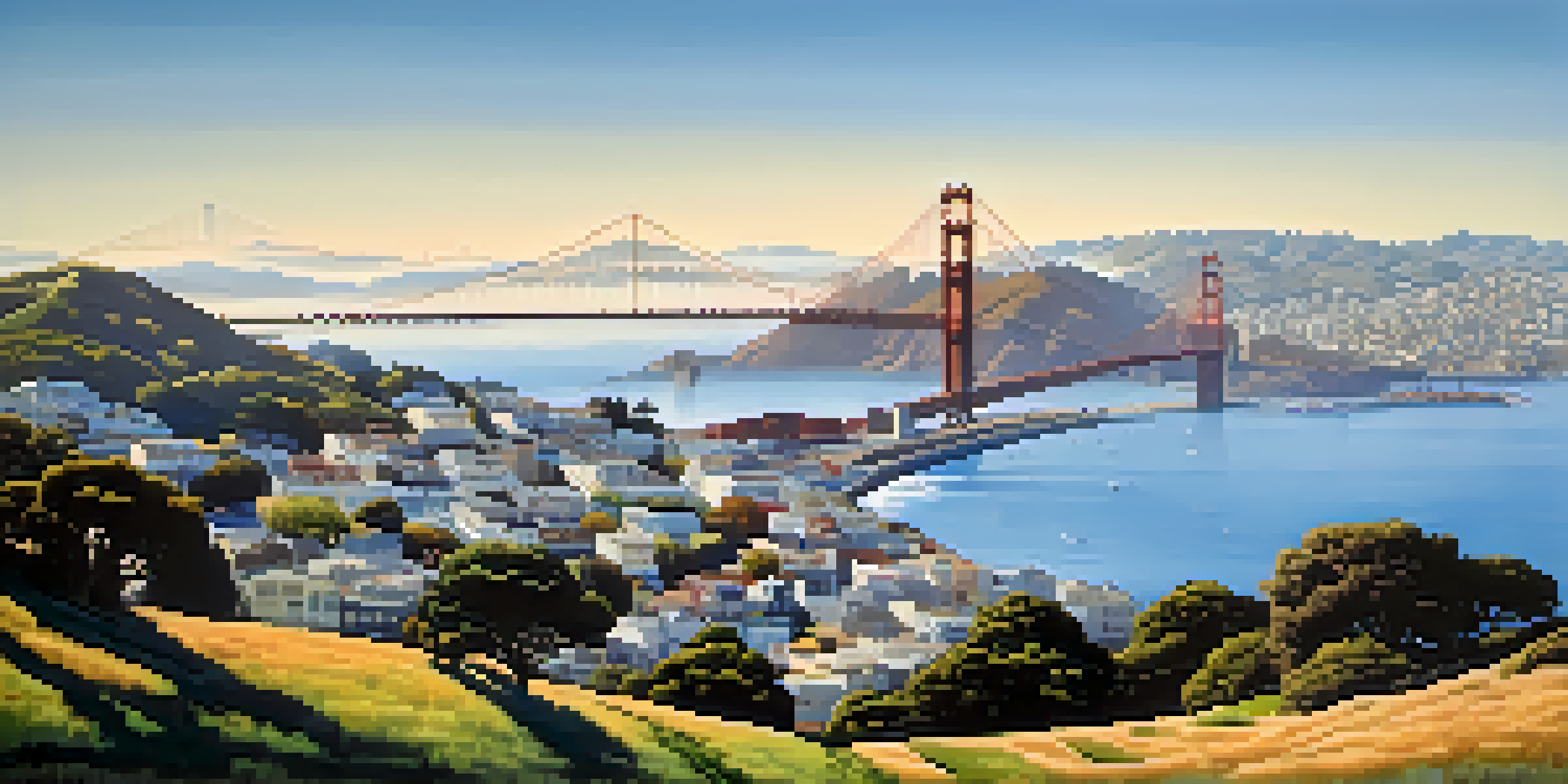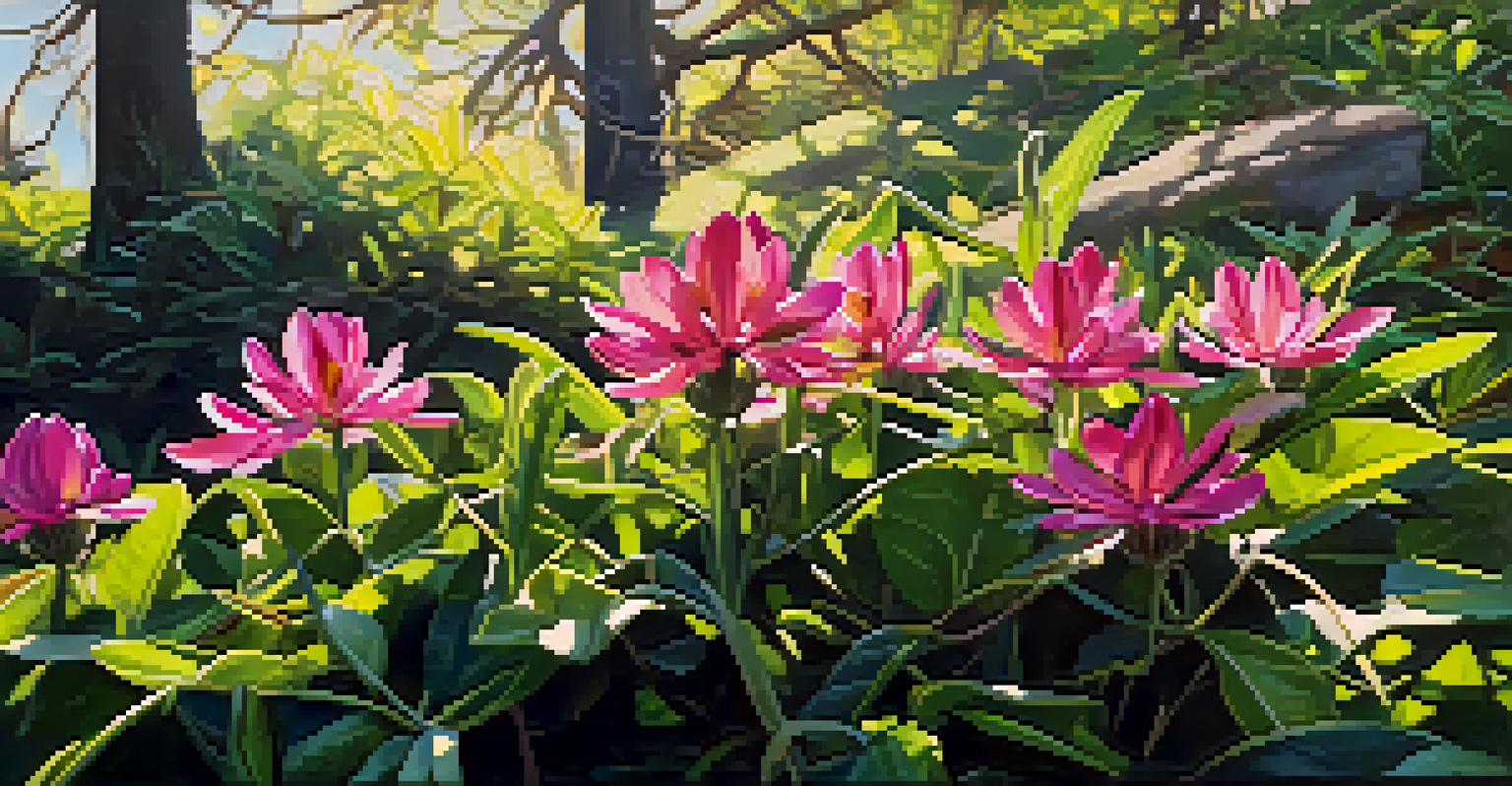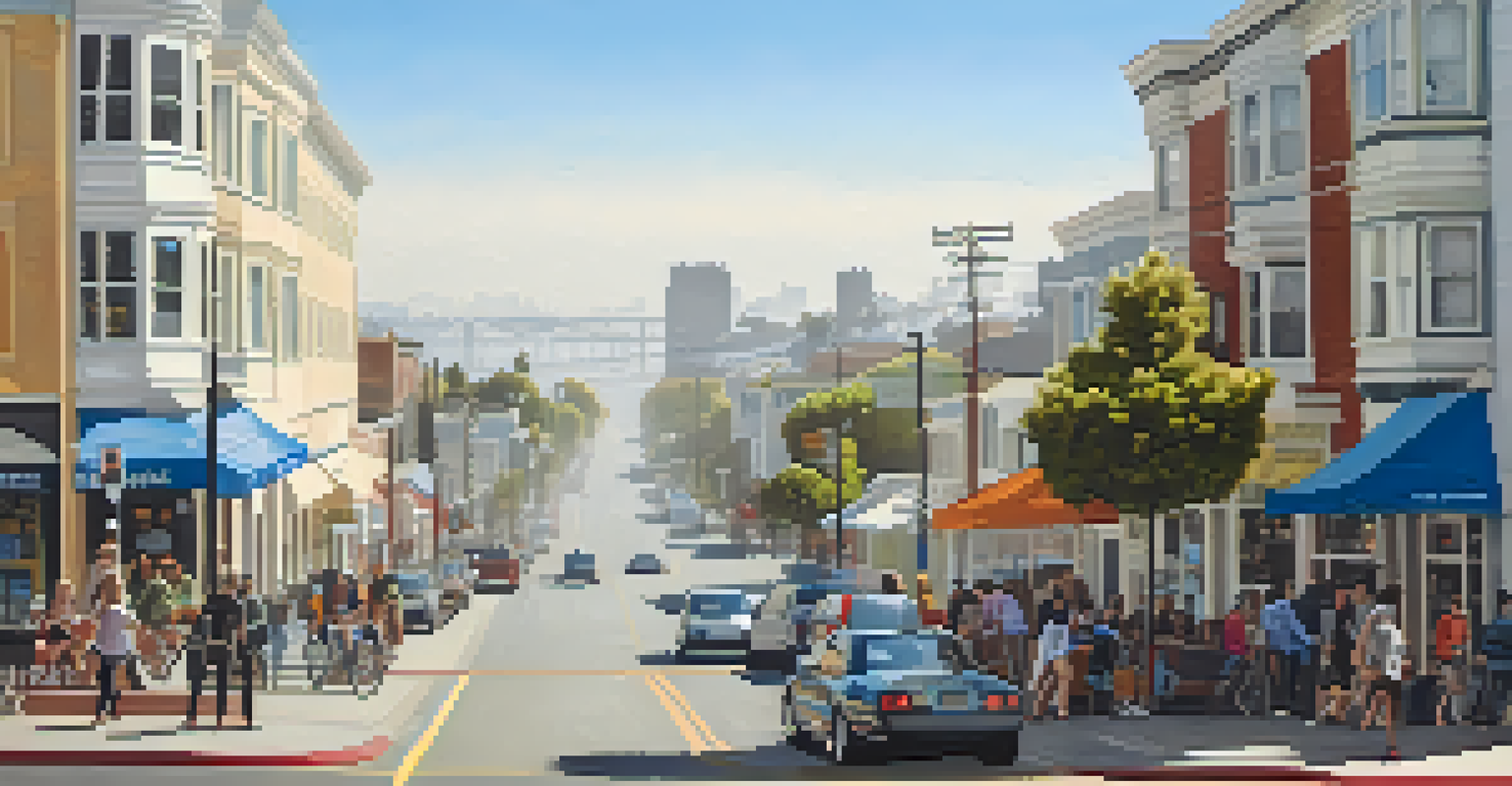How San Francisco's Topography Creates Diverse Microclimates

Understanding San Francisco's Unique Geography
San Francisco is renowned for its stunning hills, valleys, and coastlines, which create a captivating topography. This diverse landscape plays a crucial role in shaping the city's climate and weather patterns. With elevations ranging from sea level to over 900 feet, the geography creates distinct areas that experience different weather conditions.
The fog is like a dream; it envelops you, softening the edges of reality and creating a world that is both familiar and otherworldly.
The city's positioning along the Pacific Ocean further influences its climate, as cool ocean breezes interact with the warmer air from the inland valleys. This interaction results in a complex tapestry of microclimates, each with its own unique characteristics. For instance, while one neighborhood may bask in sunny weather, just a few blocks away, another area could be shrouded in fog.
Understanding this geography is essential for appreciating how microclimates impact daily life in San Francisco. From the chilly winds of the Outer Sunset to the warmer, sunnier days in the Mission District, the city's varied topography creates an ever-changing climate landscape.
The Role of the Pacific Ocean in Climate Variation
The Pacific Ocean is a significant player in San Francisco's climate narrative. It acts as a natural air conditioner, bringing in cool marine air that influences temperatures across the city. Particularly during the summer months, this oceanic breeze can lead to dramatic temperature shifts between neighborhoods that are just a short distance apart.

For example, while areas like the Marina District enjoy sunny, warm days, neighborhoods like the Richmond District may experience fog and cooler temperatures. This phenomenon is often attributed to the ocean's currents and the city's unique coastal geography. The result is a city where dressing in layers is not just a style choice, but a necessity.
San Francisco's Unique Microclimates
The city's diverse geography creates distinct microclimates that significantly influence local weather and daily life.
In essence, the Pacific Ocean not only shapes the city’s weather but also its lifestyle, compelling residents and visitors alike to adapt to the whims of nature. This interplay of land and sea underlines the beauty and complexity of San Francisco's microclimates.
Influence of Elevation on Local Weather Patterns
Elevation plays a crucial role in the microclimates of San Francisco. As one moves from the flat areas near the bay to the hills, temperatures often drop, and weather conditions can change dramatically. Higher elevations tend to experience cooler temperatures and increased wind, especially in neighborhoods like Twin Peaks.
In every walk with nature, one receives far more than he seeks.
For instance, the sunny days enjoyed in Noe Valley can quickly turn to a chilly, foggy experience just a few miles away in the Outer Mission or Glen Park. This elevation-driven variability means that local weather can be a bit unpredictable, often requiring residents to carry jackets even on sunny days.
This unique aspect of San Francisco's topography not only contributes to its diverse climates but also adds to the city's charm. The ability to experience different weather in a matter of minutes is part of what makes San Francisco such a fascinating place.
The Impact of Urban Development on Microclimates
Urban development has a significant impact on San Francisco's microclimates. Buildings, roads, and other infrastructure can alter wind patterns and heat absorption, leading to what is known as the 'urban heat island' effect. This phenomenon results in certain neighborhoods being warmer than their surrounding areas due to the concentration of concrete and asphalt.
For example, the Financial District, with its tall skyscrapers, can trap heat and create a noticeably different climate compared to areas like Golden Gate Park, which features expansive greenery. This contrast can affect everything from energy use to outdoor activities, highlighting how urban planning plays a role in climate dynamics.
Pacific Ocean's Climate Influence
The Pacific Ocean acts as a natural air conditioner, leading to varying temperatures across neighborhoods and requiring residents to adapt.
Moreover, as the city continues to grow, understanding and managing these impacts will be crucial for maintaining the delicate balance of its microclimates. Sustainable urban design can help mitigate adverse effects and preserve the unique climate characteristics that define San Francisco.
Fog: San Francisco's Iconic Weather Phenomenon
Fog is perhaps the most famous feature of San Francisco's weather, and it plays a vital role in creating the city's microclimates. Often rolling in from the Pacific, fog blankets neighborhoods, cooling temperatures and providing much-needed moisture. This phenomenon is particularly prevalent during the summer months, when inland heat draws in the cooler marine air.
Areas like the Sunset District frequently experience fog, while neighborhoods just a few miles away, such as the Mission, bask in sunshine. This stark contrast highlights the city's unique climate and adds an element of unpredictability to outdoor plans. Understanding the fog's patterns can be key for both locals and tourists looking to enjoy the city's sights.
Embracing fog as part of San Francisco's identity enhances the charm of the city. It creates a mystical atmosphere, often inspiring artists and photographers, and reminds residents of the dynamic relationship between the land and the sea.
Microclimate Effects on Local Flora and Fauna
The diverse microclimates of San Francisco have a direct impact on the local flora and fauna. Different neighborhoods provide varying habitats, supporting a wide range of plant and animal species. For instance, the coastal areas are home to salt-tolerant plants, while the hills may feature unique wildflowers that thrive in the drier conditions.
This rich biodiversity is crucial for the overall ecosystem, providing food and shelter for various wildlife. Birds, insects, and small mammals adapt to the specific microclimates, contributing to a vibrant natural environment that coexists alongside urban life. Parks and green spaces throughout the city serve as vital refuges for these species.
Urban Development's Climate Impact
Urbanization alters wind patterns and heat absorption, creating warmer 'urban heat islands' that affect local climates and ecosystems.
Understanding how microclimates influence local ecosystems helps residents appreciate the natural beauty surrounding them. It encourages a sense of stewardship for the environment, promoting efforts to preserve and enhance these unique habitats.
Tips for Navigating San Francisco's Microclimates
Navigating the diverse microclimates of San Francisco can be a challenge, but a few tips can make it easier. First, always check the weather forecast before heading out, as conditions can vary significantly from one neighborhood to another. A sunny morning in one area may turn into a foggy afternoon just a few blocks away.
Layering clothing is another effective strategy. By wearing multiple layers, you can easily adapt to changing temperatures as you move throughout the city. This approach not only keeps you comfortable but also allows you to embrace the city's unique climate variations.

Finally, take the time to explore different neighborhoods and experience their unique weather patterns. Each area has its own charm and character, shaped by the microclimates that define them. Embracing this diversity is part of what makes visiting or living in San Francisco such a rewarding experience.